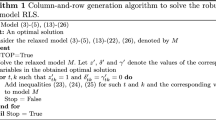Abstract
This paper addresses a particular stochastic lot-sizing and scheduling problem. The evolution of the uncertain parameters is modelled by means of a scenario tree and the resulting model is a multistage stochastic mixed-integer program. We develop a heuristic approach that exploits the specific structure of the problem. The computational experiments carried out on a large set of instances have shown that the approach provides good quality solutions in a reasonable amount of time.
Similar content being viewed by others
References
S. Ahmed, A.J. King, and G. Parija, “A multistage integer programming approaches for capacity expansion under uncertainty,” Journal of Global Optimization, vol. 26, pp. 3–24, 2003.
S. Ahmed and N. Sahinidis, “An Approximation scheme for stochastic integer programs arising in capacity expansion,” Operations Research, vol. 51, pp. 461–471, 2003.
A. Allahverdi, J.N.D. Gupta, and T. Aldowaisan, “A review of scheduling research involving set-up consideration,” Omega, vol. 27, pp. 219–239, 1999.
A. Alonso, L. Escudero, and M.T. Ortuno, “A stochastic 0–1 program based approach for the air traffic flow management problem,” European Journal of Operational Research, vol. 120, pp. 47–62, 2000.
P. Beraldi, G. Ghiani, A. Grieco, and E. Guerriero, “Heuristic algorithms for the scheduling of parallel machines with sequence dependent set-up costs,” submitted to Journal of Scheduling.
A.R. Clark and S.J. Clark, “Rolling-horizon lot-sizing when setup times are sequence dependent,” International Journal of Production Research, vol. 38, pp. 2287–2308, 2000.
CPLEX 7.0: User's Manual, CPLEX Optimization, Inc., Incline Village, NV, 2001.
P. M. Dearing and R.A. Henderson, “Assigning looms in a textile weaving operation with changeover limitation,” Production and Inventory Management, vol. 25, pp. 23–31, 1984.
Ch. Dillenberger, L.F. Escudero, A. Wollensak, and W. Zhang, “On practical resource allocation for production planning and scheduling with period overlapping setups,” European Journal of Operational Research, vol. 75, pp. 275–286, 1994.
A. Drexel and A. Kimms, “Lot sizing and scheduling; Survey and Extensions,” European Journal of Operational Research, vol. 99, pp. 221–235, 1997.
L.F. Escudero and J. Salmeron, “On a fix-and-relax framework for large-scale resource-constrained project scheduling,” to appear on Annals of Operations Research.
K. Haugen, A. Løkketangen, and D.L. Woodruff, “Progressive hedging as a meta-heuristic applied to stochastic lot-sizing,” European Journal of Operational Research, vol. 132, pp. 116–122, 2001.
A. Løkketangen and D.L. Woodruff, “Progressive hedging and tabu search applied to mixed integer (0,1) multistage stochastic programming,” Journal of Heuristics, vol. 2, no 2, pp. 111–128, 1996.
G. Lulli and S. Sen, “A branch-and-price algorithm for multistage stochastic integer programming with application to stochastic batchsizing problems,” Management Science to appear.
H. Meyer, “Simultaneous lot-sizing and scheduling on parallel machines,” European Journal of Operational Research, vol. 139, pp. 277–292, 2002.
M. Pinedo, Scheduling Theory, Algorithms and Systems, Prentice Hall, 1995.
Y. Pochet, “Mathematical programming models and formulations for deterministic production planning problems,” in Computational Combinatorial Optimization, M. Jüunger and D. Naddef (Eds.), Springer Lecture Notes in Computer Science, 2001, pp. 57–111.
A. Ruszczyński, “Probabilistic programming with discrete distributions and precedence constrained knapsack polyhedra,” Mathematical Programming Ser. A, vol. 93, pp. 195–215, 2002.
S. Sen, “Algorithms for stochastic mixed-integer programming models,” Working Paper, MORE Institute, SIE Dept., University of Arizona, Tucson, AZ., 2003.
A.T. Staggemeier and A.R. Clark, “A survey of lot-sizing and scheduling models,” in Proceedings of the 23rd Annual Symposium of the Brazilia Operational Research Society, Campos do Jordo, Brazil, 2001.
A.T. Staggemeier, A.R. Clarkand, U. Aickelin, and J. Smith, “A hybrid genetic algorithm to solve a lot-sizing and scheduling problem,” Report MS-2002-4, Intelligent Computer Systems Centre Group, University of the West of England, Bristol, Great Britain, 2002.
H.M. Wagner and T.M. Whitin, “Dynamic version of the economic lot size model,” Management Science, vol. 5, pp. 89–96, 1958.
L.A. Wolsey, “MIP modelling of changeovers in production planning and scheduling problems,” European Journal of Operational Research, vol. 99, pp. 154–161, 1997.
Author information
Authors and Affiliations
Rights and permissions
About this article
Cite this article
Beraldi, P., Ghiani, G., Grieco, A. et al. Fix and Relax Heuristic for a Stochastic Lot-Sizing Problem. Comput Optim Applic 33, 303–318 (2006). https://doi.org/10.1007/s10589-005-3055-2
Received:
Revised:
Accepted:
Published:
Issue Date:
DOI: https://doi.org/10.1007/s10589-005-3055-2




